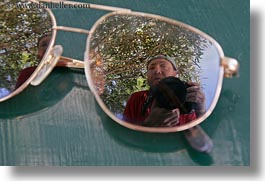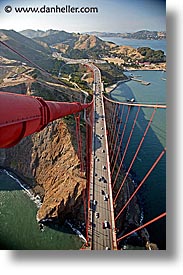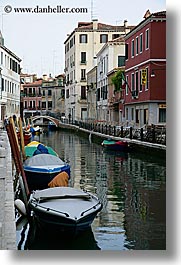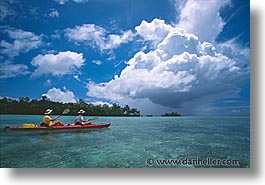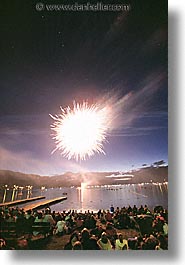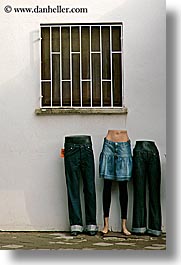|
Markers indicate locations for photos on this page.
Accuracy responsibility of Google Maps
Google Map Goes Here
If you see this text, the map is still loading (or there's an error). |
Success in the photo business has nothing to do with how good you are, nor does it matter what you shoot, or whether you specialize in a subject, or have a very broad repertoire. Success is the direct result of one and only one thing: business sense. A great photographer can fail miserably because he has no business skills, but a lousy photographer can succeed by simply being good at business, regardless of the topic or skilset (good or bad). In short, it's this simple: if you want a photography career, you don't have to be a better photographer, just a smarter one. This is what I call "business sense."
How do you study business sense? You don't. Business is more of an art
than a science. It's true that there are business mechanics, such
as forming a company and learning about tax and general accouting
principles, but you can learn that stuff from any business book. The
kind of effective thinking that makes one successful in any business
goes beyond mechanics. You need to know basic economic principles like
supply-and-demand, marketing strategies of attracting clients, pscyhology
of choosing, and other higher-level concepts. And when you start thinking
in those terms, what you end up doing is thinking ahead. You're
no longer thinking about how you get your next assignment, or how to
price that photo someone wants to buy or license, you start thinking in
broader career-development terms: How can you set up a business model
that scales up, that generates repeated interest, that allows prices
to rise without haggling?
There are three essential stages in developing business sense, each of which corresponds to different stages of career development. (This isn't a coincidence; career development is usually the by-product of having mastered each of these stages.)
The first step in developing a mature sense for business is learning to see the long-term effects of the decisions you make. This awareness often comes in retrospect after you've been doing the same thing repeatedly and you see how benefits (or costs) that weren't apparent before, are clear now. Time's role in this is pivotal because developing a career requires time to experience those events, to witness the cause-effect relationship between decisions and actions, and to develop good analytical tools to objectively measure those results. The sooner you learn sound business analysis in terms of longer-term benefits, the quicker your career develops. I'll get into details of this later. As you go through experiences that make you realize long-term goals are rarely achieved by only shooting for short-term objectives, you then realize you've been very inefficient in your decision-making.
The realization to think this way often comes as a result of a different realization: business isn't growing. The immature business mind usually confuses efficiency with effectiveness. More often than not, you probably shouldn't even be doing many of those tasks in the first place, even though you are doing them very, very well. The mature business mind is willing to let go of those tasks that aren't necessary, and instead spend time doing other things that contribute more to building your career. Effectively executing your longer-term strategies involves making many attempts. Your first sale is a pivotal event, because you look back on what you've done up to that point, and gain an instant (albeit simplistic) understanding of what you did right, and what you did wrong. Seeing the cause-effect of actions and results helps formulate what will eventually form the second stage of the learning process: how to strategize.
By this time, you've developed efficiencies into your methods, combined your methods into strategies, and are now applying them to real business growth. Negotiation: Should you bid an assignment for more or less money? Strategy: Are you wasting time competing for assignments that are beneath you, even if you aren't getting the work? Social Decorum: Are you overly confident when speaking in public or with decision-makers? Self-Honesty: Were you lucky in getting chosen above others, or was it deserved success? Strategies help guide you on decision-making, but choosing among decisions are best made when you're aware of your own real strengths and vulnerabilities.
Now that we've identified the stages of developing a mature model for
business sense, let's get into the details of each.
During those early career-development stages, opportunities will come
your way—some will look like great break through's, whereas others
are duds. But, what you see on the surface may not be as it seems.
Weighing the cost/benefits between short-term and long-term objectives
is the most important aspect of smart business thinking. For example,
consider this brief list of criteria that is often cited as considerations
for a business opportunity:
There's no question that each of these are important, but not every business model requires the same answers to be true for it to be a "good opportunity." For example, some assignments may pay a high shooting fee, but you don't get to keep the images. Someone who needs immediate cash may find this a good opportunity, whereas the career stock photographer wouldn't find it beneficial. Not all assignments will pay both a good fee and let you keep the images (where they license them back from you), though some will. Is it good business sense to only participate in those opportunities that have optimal returns? As Charlie Brown once said,
Many pro photographers said I was hurting their business by lowering the perceived cost of photographers, and that I should charge money for my services. And if I did it for free now, they said, I would establish a low-water mark, and they'd never pay me for any kind of assignment in the future, To me, I saw one main problem with this logic: the film festival simply had no budget to pay photographers; everyone who did odd jobs during the event was a volunteer. In the case of the photographers, most were inexperienced amateurs, much like me. Hence, if I didn't do it, some other non-professional would. So, I wasn't hurting anyone's business, nor was I establishing a low price point for my services. Instead, I was simply gaining experience. What I didn't expect was to be in front of filmmakers and others who, by the nature of their industry, became potential business opportunities for me. Best of all, I had almost no competition around me—the professional photographers boycotted the event, and everyone else was a non-pro with no interest in getting more photo work. Through the people I met at this event, I generated about $5000 worth of new business over the course of the next year.
This example illustrates that longer-term benefits can outweigh the
lack of short-term financial gain if you use them to your advantage.
But, it's equally important to maintain perspective. Today, I no
longer "need" to shoot assignments for free, because I get work from
clients who are willing to pay my rates because they know what they're
going to get. However, my analysis of business opportunities hasn't
changed.
I consider all possible ways I can make any given assignment favorable
before I let it go, but that doesn't mean they carry equal weight. The
values you attribute to each is dependent on your individual career goals.
My only warning is that a disproportionate weighing on any one factor is
often a sign of overly focusing on short-term strategies. For example,
if you dismiss an assignment simply because it is a work-for-hire
contract, without even considering the other items, you're not thinking
strategically. Having good business sense means that you favor long-term
opportunities.
"There's this art festival I saw when I was on vacation that's so great that travel magazines would just love it! I'm going to go back and take a lot of pictures, and sell them to editors, because no one else is covering this event! She was so convinced that her enthusiasm would be shared by others, that in her mind, it'd just be a matter of unearthing this latent demand by showing the pictures to photo editors.
My friend's long-term objectives had not been defined yet; she was driven solely by short-term goals that were unlikely to succeed. And even if she were able to publish some photos, they wouldn't really amount to much. Career-building involves capitalizing on previous successes to leverage future plans, rather than floating from one idea to the next without a coherent plan.
The broader point is that long-term strategic thinking involves looking
at every moment of time you spend, and justifying how it contributes to
growth. We'll return to this subject later in this chapter.
This is what I call the GLOSSARY:low-hanging-fruit fallacy: DEFINITION:low-hanging-fruit fallacy In reality, there is a rather high hurdle that separates the time, work and effort required to start a photo business, and the making of a self-sustaining and viable business. That is, the growth curve isn't linear, and what often happens is that people get too optimistic when the quick sales happen right away, only to be completely unprepared when the low hanging fruit runs out. The common example is when someone tells her friends she's starting a portrait business, and she get all her friends and family as first clients. Words spreads, and things seem to be running fine, but after the first round of easy sales has been exhausted, business dries up. I have seen many amateurs, many of whom are far more talented than I, simply give up because of the frustrations and pitfalls. Success isn't easy, and one should be wary of any successes that seem "too easy," especially when it happens quickly.
To keep a business going beyond the first few rounds, one needs to see
not just the long-term strategy, but begin to make effective decisions
that realize those goals. In the development cycle of business sense,
the first level may have been achieved, but the second level wasn't. So,
let's discuss that next.
Both are critical, but don't confuse one for the other. Whatever you're doing at any given time means that you're not doing something else. Are you doing what needs to be done? Might something else be a better use of your time? When emerging photographers fail to achieve this balance, it's because they either choose to do things they "like" (or want) to do, or those things they incorrectly prioritize (even if they're bad at it). This is a phenomenon that I call . When business stagnates, it's because of the circular dependency of feeling that business can't progress until other tasks are done first, which never get done because business isn't progressing.
Because I know her, I see what's going on at home. She spends most of her time repeating the same tasks over and over: when she writes an invoice, she starts from a blank page in her word processor, and redesigns the enter thing from scratch, unaware that she can make a template. She's constantly re-calculating her budgets, cleaning her studio, and calibrating her monitor. All these activities are justified because, she says, "when business comes, I'll be prepared." Why not invest in other things first? "That costs money, and I'll spend that money when the business can pay for it." You and I can see all sorts of things she's doing wrong, plus add a bunch of other things she should be doing to move forward. But, don't let your ability to see the fault in other people give you the false confidence that you'll see it in yourself when it happens to you. Those who get stuck, including (especially) the pros, they never see it in themselves; they always have rational reasons for their lack of progress.
Choosing between tasks is easier when you're the objective observer.
You can see my friend doesn't need to be calibrating her monitor all the
time. But, will it be so easy to see when you find you don't have
enough time to do things that seem important? Will you make a
portfolio to send to the art director, or will you get that website up
and running? Making tougher decisions is where the exercise gets more
challenging. We'll be looking at this in more detail in Marketing your Photography Business.
Your job is to diminish luck's role as you and your business mature. Part of having good business sense is knowing when luck ends and "deserved success" begins. The reason this is the final stage of development is because you may hit a dead end in your career if you don't really have a good sense of yourself that gets you by the tougher times. You may have good strategies and your business decisions are adequate, but as pointed out earlier, you come up with a lot more ideas than those you actually act upon. When your career is stuck it could be that you're stuck in a narrower pattern of decision-making that isn't serving your goals, and it's all because you're perception of self doesn't match what the outside world thinks. The graveyard of business failures is populated with many who look back regretfully and say, "I got too arrogant for my own good."
Do you bid it straight up, as if you were one of the regular go-to shooters? Do you underbid a little in acknowledgment of your inexperience, or do you push it a tad higher because you know they're in a bind? There is no right or wrong answer here—it's a rhetorical challenge to get you to think in terms of yourself. You should review the "assignment evaluation" checklist earlier in the chapter as a guide, since a lot of those items compel you to take into account your own sense of self. If you're right about yourself and your assessment of this opportunity, your actions will match the expectations of the client, and you'll get the job. One very important factor in this scenario that you need to consider, is the fact that you were chosen because of potential merit, not realized merit. Being hired for potential is great, but it's still a factor of luck—many people have potential. Whereas, realized merit is "deserved," merit you have earned from proven experience.
Compare this with a more challenging scenario: the art director's colleague highly recommended you as an experienced photographer, and you are then asked to bid the assignment. Same questions as before: how do you bid? Here, your "deserved success" is present in both cases: the portfolio was strong, and you were chosen as a known entity. What's more, your portfolio was not sent unsolicited, and the client is in a bind because their regular go-to shooters aren't available. If you think it is a good time to bid higher, you may be right, but here's where people get ahead of themselves: you're still an unknown entity to that particular art director. If you want to establish a longer-term relationship, your bid may be affected. If it's a one-time job for good money, your bid may be different.
As you go through your business, no matter how talented or smart you are,
having the ability to distance yourself from yourself, to see your own
misgivings, and to see your situations objectively, is critical to making
better decisions. An inflated sense of self can be your own worst enemy,
just as diminishing your own value can be equally crippling. Strive for
accuracy in self-perception, not just an ego-boost. If you do this well,
you may achieve a level that everyone in any art form hopes for: name
recognition. (This will be dealt with in detail in Marketing your Photography Business.)
When it comes to listening to business advice, the analogy I like to draw is "the room full of lottery winners." If you take all the people who won more than one million dollars in the lottery, and assemble them in a big stadium, most would claim to have "some technique" for picking winning numbers. But we really know: they were just lucky. (You're with me on this, right?) The fact that they are all together gives the illusion of credibility. Quote time:
It's important to understand that anecdotal evidence of success does not demonstrate a pattern. Analysis of advice should be one that can be tested across a wider sampling of the population, not necessarily just the one pro, or even the stadium full of lottery winners. This invariably leads to the bandwagon effect: that phenomenon where everyone does the same thing because that's what everyone else does. It's understandable, because it feels safe and reliable. This reminds me of when the 9/11 Commission gave its report on why the intelligence got it so wrong when they thought that Iraq had weapons of mass destruction. There was this classic comment:
For example, I've heard pros say that their job is to be the "creative talent", and the rest of the tasks should be done by outside professionals who are skilled at such matters. The reason this doesn't work for the independent photographer is the loss of control, efficiency and effectiveness. Obviously, you aren't an expert in every field of business, and outside help is critical and necessary; you need to rely on others' expertise. But, if you don't know exactly what needs to be done, why, and how, then I guarantee that it won't be done right, even by professionals with the best intentions. Outsourced "tasks" aren't just robotic activities that someone does for you. Strategic business decisions need to be made that affect how each of those processes are done. You need to understand the ramifications of those decisions with their help as advisers and experts, not as hired hands who just do the job for you. Hiring a lawyer $250 per hour will cost you thousands more if you just leave matters in his hands. Worse, he may be ineffective simply because he doesn't have your long-term business objectives in mind. (Nor might he be able to identify with them.) If you don't know this stuff, your lawyer is never going to advise you in any way that will help you in the end.
When you get outside help, your job is to learn as much as you can from
these people so you can use them sparingly, if ever. And if you do need
them, you will know why, and can direct them efficiently.
One could say from the beginning that my business has always a Web-only concern, where most of my revenue comes from online sales. This doesn't mean that I don't engage in other marketing or promotional activities offline as well. I do. But, the main goal is to bring that target audience to my site. Those marketing activities do not include sending mass mailings to unknown clients, or unsolicited portfolios to photo editors or art directors, or mailing postcards directly to buyers in hopes of getting new clients. For me, the cost-benefit never justified those efforts or expenses (see Marketing your Photography Business). I repeat: for me. Because the net was already doing such good business for me, I didn't have the need to spend the time and resources in other ways. Most of my business is so saturated, that it has never been a matter of getting "enough" business, it's more a matter of improving the efficiency of it, so that I can reduce the amount of time I need to spend with each sale.
While assignments only represent between 5-7 percent of my revenue, those provide images that fuel 95 percent of my sales. As before, I continue to shoot for active/adventure travel outfitters who send me on trips with other guests so they can use my pictures for their marketing. I shoot the entire experience: the country, the places we stay/eat at, culture, people, architecture, whatever. The client uses those photos in their catalogs, direct mailers, or anything they create to promote their businesses. That's where my relationship with the client ends (except for recurring assignments). Where the bulk of my business picks up is from the aftermarket sales of those same images as fine art and stock photography. Again, for the broader perspective of the market, there are many other kinds of models, such as wedding and portrait photographers, who pull in 90 percent of their revenue from assignments, and 5 percent or more from other sources like stock or print sales. What's more, a name-brand shooter in strategically-placed markets or industry segments can make a respectable living. There are many models to choose from, so don't get caught up in thinking that mine or any other singular approach is "correct."
About 40-50 percent of my business comes from selling "fine art prints." Briefly, I define fine art as a custom-made print that I produce and whose use is solely to display as artwork. This is my highest-margin sale, and most consistently priced. It's also the most efficient sale, since it takes no negotiation, no sales pitch, and no product delivery or follow through. The order comes in, it's done, I move on. One doesn't have to try hard to illustrate the fantastic advantages of selling online. The question isn't "whether" to do it, it's how you get the orders, and what are the best price points. (Those are discussed in separate chapters.) Upon observation, you may ask, since fine art represents so much of my revenue, and it's easier and quicker with less overhead than other types of sales, why don't I price (and market) my "art" more aggressively to yield higher volumes? The reasons I don't are somewhat complicated because it's not just a see-saw of price vs. volume. Other costly factors get involved as prices fluctuate: the time and other customer service matters emerge as prices drop, because "consumers" become the audience. These are the "tire kickers," where the amount of time and resources necessary for customer service, shipping, and other things that "go wrong" in the day-to-day running of affairs can eat you from the inside out. Worst of all, there is a lot of time consumed with queries that don't lead to sales. Higher-priced images appeal to a very different kind of buyer, making a smoother sales cycle, but one runs into another example of the law of diminishing returns: if prices are too high, sales drop. So, the trade-offs are challenging, but more frustratingly is the fact that there is no reproducible formula. What works for other never worked for me, and what works for me hasn't shown much success with others. My explanation for this is non-scientific, but I suspect that the nature of my imagery, topics, style, marketing idiosyncrasies and other factors, all create a unique demographic specific to me. Thus, my price points work with that demographic.
Selling images for licensing like this is called stock photography, and
that's an enormous subject to cover. For more on this, see The Stock Photography Business.
The price points for stock photography is also a bigger, more complex subject,
and that's addressed in Photography Pricing.
Clearly, my long-term objective is to fill my stockpiles of images through my assignments. But that doesn't mean that all assignments have value, or are created equally. There are trade-offs. I retain copyright and to re-license the images in the aftermarket, making the reciprocal value between me and my client mutually beneficial. An assignment that doesn't let me keep the images must make up for that lost revenue somewhere else (usually the assignment fee). Review the checklist earlier in this chapter. I've done assignments where I don't own anything and don't have any relicense rights, but I also get paid $10,000 and more for a one or two-day shoot. Those are great revenue-generators that shouldn't be dismissed out of hand. They're just not part of my long-term strategies, but that doesn't mean they can't be part of yours. If your business model is to become well-known for such assignments, you don't need to worry about stock photography and sales; you can earn good money if you get one assignment a month. (But, don't get your hopes too high on that one—if it were that easy, everyone would do it.)
I had made reference to the expression, "well-known." The reason some
photographers can get $10,000 assignments is because they are well-known
in their market segments. Fashion, for example. To get there, part of
the business strategy has to be name-brand generation, as discussed in
Marketing your Photography Business. This is not a simple thing to do, but it's also not out
of reach for people. I happen to choose a business model that doesn't
require name recognition because I don't do well with notoriety. There's
a personality style necessary to go along with that, and I don't have
it. If you value this benefit and your personality allows you to develop
"fame" in that way, you might choose a business strategy that leverages
those traits in you. Again, this reinforces the notion that there is no
one business model that's right for every photographer.
There are many different kinds of photo businesses, from the portrait photographer in the mall, to the press photographer for the local newspaper, to the stock photographer out in the field that takes pictures of nothing but birds. Every field of photography has a different degree of demand for such products, different competition, and different regional variances that may make that work more or less worthwhile as a career objective. What you develop your career into is entirely up to you. But it won't go anywhere unless and until you develop a sense for business.
Click to recommend this page: |
|
